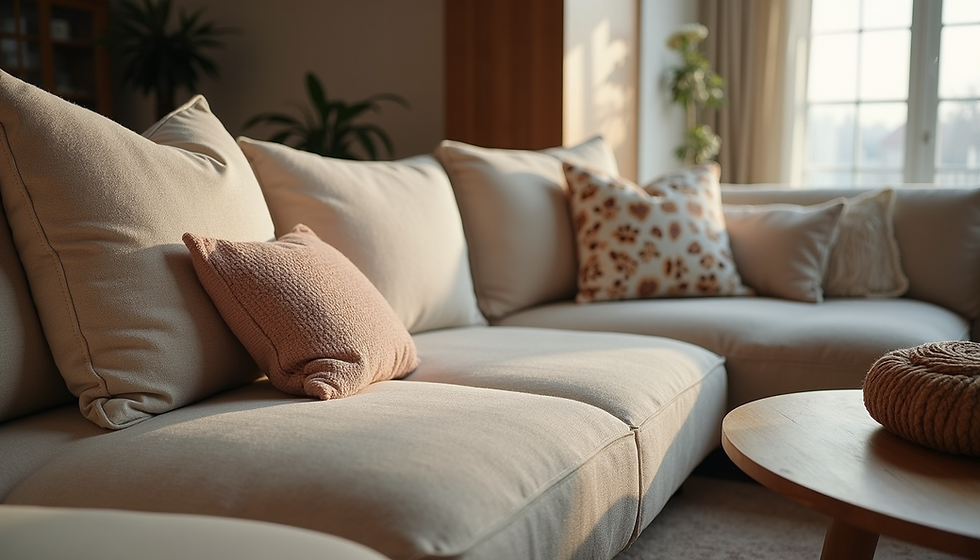Emphasis in Interior Design
- Jayant Upadhyay
- Aug 1
- 4 min read

Table of Contents
Introduction to Emphasis in Interior Design
What Is Emphasis in Interior Design?
Why Emphasis Matters in Interior Design
Types of Emphasis in Interior Spaces
Key Elements That Help Create Emphasis
Emphasis vs. Balance: Finding the Right Harmony
Common Mistakes to Avoid
Emphasis in Different Interior Styles
Case Studies: Real-Life Examples
Tips for Creating Emphasis in Your Space
Emphasis in Small vs. Large Rooms
Conclusion
FAQs
1. Introduction to Emphasis in Interior Design
When you walk into a room and your eyes are instantly drawn to a piece of art, a fireplace, or even a dramatic light fixture—what you’re noticing is emphasis in action. It’s one of the foundational principles of interior design, and when used effectively, it gives a space identity, cohesion, and visual interest.
2. What Is Emphasis in Interior Design?
In simple terms, emphasis refers to the strategic use of design elements to draw attention to a specific area or object within a room. This “focal point” becomes the visual anchor that holds the design together. Whether it's an architectural element or a carefully selected piece of decor, emphasis directs the eye and creates a sense of purpose in the layout.
3. Why Emphasis Matters in Interior Design
Without emphasis, a room can feel chaotic or flat. Here's why emphasis is essential:
Creates Visual HierarchyEmphasis tells the brain where to look first, helping create a logical flow and structure.
Adds Drama and PersonalityBold focal points like accent walls, statement furniture, or lighting fixtures can infuse a room with character.
Supports the Room’s FunctionIn a living room, emphasis might be on the fireplace. In a kitchen, it could be the island. It makes the function more intuitive.
4. Types of Emphasis in Interior Spaces
A. Architectural Emphasis
These are built-in features like arched windows, exposed beams, or staircases that naturally draw the eye.
B. Color Emphasis
Contrasting or bold color choices immediately command attention. Think of a red accent chair in a neutral room.
C. Textural Emphasis
Materials like stone, wood, or velvet can be used to create emphasis through touch and sight.
D. Lighting as Emphasis
Statement chandeliers or under-cabinet lighting can become the highlight of a space.
E. Furniture or Decor Emphasis
A dramatic piece of furniture or a large painting can serve as the focal point.
5. Key Elements That Help Create Emphasis
To effectively apply emphasis in interior design, consider the following elements:
Scale and ProportionLarger items or features naturally grab more attention.
Color and ContrastA splash of vibrant color in an otherwise muted room creates immediate emphasis.
PlacementCentering an object or placing it at eye level ensures it’s noticed.
LightingSpotlights or directional lighting can elevate even a simple object into a focal point.
TextureRough vs. smooth, shiny vs. matte—texture differences can highlight a specific area.
6. Emphasis vs. Balance: Finding the Right Harmony
While emphasis draws attention, balance ensures the room doesn’t feel lopsided. Overemphasizing can create a visually heavy space. Strive for:
One dominant focal point
Supporting secondary points
Balanced negative space
7. Common Mistakes to Avoid
Avoid these pitfalls when incorporating emphasis:
Multiple Competing Focal PointsToo many strong elements can confuse the viewer and dilute impact.
Ignoring ScaleA tiny wall art piece on a large empty wall won't create sufficient emphasis.
Lack of ContrastIf the focal point blends into the surroundings, it won’t stand out.
Inconsistent StyleEnsure your emphasized element aligns with the room’s overall style.
8. Emphasis in Different Interior Styles
Modern
Clean lines and minimalism often use emphasis via large art, monochromatic contrast, or bold lighting.
Traditional
Ornate fireplaces, heavy drapery, or classical paintings often serve as the focal point.
Industrial
Exposed brick or ductwork often acts as architectural emphasis.
Bohemian
Bold colors, layered textiles, and curated decor create visual emphasis through eclecticism.
Scandinavian
A minimal space may highlight a single piece of furniture or art with subtle emphasis using lighting and shape.
9. Case Studies: Real-Life Examples
Case Study 1: Urban Loft Living Room
A reclaimed wood wall serves as a textural emphasis in an otherwise concrete-heavy space.
Case Study 2: Minimalist Bedroom
A large, abstract painting above the bed acts as a serene focal point, drawing attention without clutter.
Case Study 3: Luxury Bathroom
A standalone bathtub centered under a chandelier and framed by large windows creates a spa-like emphasis point.
10. Tips for Creating Emphasis in Your Space
Use contrast wisely: Pair bold with neutral.
Embrace asymmetry: A single focal point doesn’t always have to be centered.
Incorporate movement: Use lines or pathways to guide the eye toward the focal point.
Layer your emphasis: One strong focal point, then support it with secondary features.
Use mirrors or lighting to enhance a focal feature.
11. Emphasis in Small vs. Large Rooms
Small Rooms
Stick to one focal point.
Use mirrors or lighting to avoid crowding.
Keep colors simple but use a bold accent (e.g., throw pillow, art).
Large Rooms
You can incorporate multiple layers of emphasis.
Use zone lighting to define different areas.
Consider architectural emphasis like built-ins, ceiling design, or large-scale art.
12. Conclusion
Emphasis is more than just a flashy centerpiece—it’s about guiding the visual narrative of a space. A well-placed focal point brings harmony, enhances functionality, and elevates the aesthetic. Whether you’re designing a living room, bedroom, or commercial space, understanding how to implement emphasis in interior design will ensure your space is both beautiful and intentional.



Comments